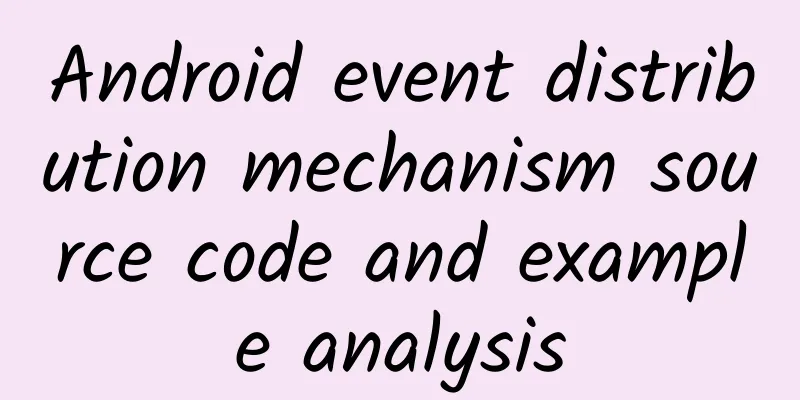Android event distribution mechanism source code and example analysis

|
1. Understanding of the event distribution process 1.1. Overview 1.2. Main methods 1.3. Core Behavior 1.4. Special Cases 2. Case Analysis 2.1. Case 1: No down event is consumed 2.2. Case 2: View0 consumes down event 2.3. Case 3: ViewGroup2nd consumes down event 3.down event distribution diagram 1. Understanding of the event distribution process 1.1. Overview The main events are down (MotionEvent.ACTION_DOWN), move (MotionEvent.ACTION_MOVE), and up (MotionEvent.ACTION_UP). Basically, gestures start with a down event and end with an up event, with a certain number of move events in between. These three events are the basis of most gestures. Events and related information (such as coordinates) are encapsulated into MotionEvent. The general distribution process is: first pass it to the Activity, then pass it to the Window to which the Activity is attached, then pass it from the Window to the top View of the view, that is, DecorView, and finally distribute it from DecorView to the entire ViewTree. There is also a backtracking process for distribution, and finally it returns to the call of the Activity. Activity distribution event source code
In getWindow().superDispathTouchEvent is used to distribute events to DecorView. If the entire ViewTree does not consume the event, the onTouchEvent of the Activity will be called. 1.2. Main methods 1.2.1. Overview The main methods of View or ViewGroup involved are: dispatchTouchEvent, this method encapsulates the entire process of event distribution. It is the dispatcher and commander of event distribution. The core process is in this method. The following onInterceptTouchEvent and onTouchEvent callbacks are called in this method body. Whether to pass the event to onInterceptTouchEvent and onTouchEvent are determined by dispatchTouchEvent. onInterceptTouchEvent, this method determines whether to intercept the event. Only ViewGroup has this callback. Return true to intercept, return false to not intercept. When customizing View, you can override this method and use some specific logic to decide whether to intercept the event. If intercepted, the onTouchEvent of the ViewGroup will be called to handle the event. onTouchEvent, this method processes the event and decides whether to continue consuming subsequent events. The prerequisites for calling this method are:
This method formally processes MotionEvent. Return true to consume, return false to not consume. If consumed, the following events will be passed to the dispatchTouchEvent of the View; if not consumed, the following events will not be passed. The onTouch callback of onTouchListener, like onTouchEvent, has a higher priority than onTouchEvent. If the listener is set and onTouch returns true, onTouchEvent will not be called again. If it returns false, the event will still be passed to onTouchEvent. 1.2.2. Some details in the dispatchTouchEvent method: Most gestures start with a down event. If dispatchTouchEvent receives a down event, it will reset some variables and flags. Reset variables and flags source
In the actual source code, ViewGroup inherits from View. When the child View does not consume the event or ViewGroup intercepts the event, it will pass a null value to dispatchTransformedTouchEvent, which will call super.dispatchTouchEvent internally and eventually pass the event to onTouchEvent for processing. dispatchTransformedTouchEvent Key Part
That is, dispatchTransformTouchEvent completes the *** process of distribution: a. If the passed child is not empty, convert the coordinates to the child's coordinate system and call child.dispatchTouchEvent to dispatch the event to the child. b. If the passed child is empty, call super.dispatchTouchEvent to distribute the event to onTouchEvent 1.2.3 Main relationships of methods For a ViewGroup, the relationship between several important methods is as follows Several important method relationship pseudocode
This is a simplified description of the event distribution process, which is much more complicated than this. 1.3. Core Behavior View or ViewGroup has two core behaviors: intercept and consume. These two are independent of each other. Intercepting does not necessarily mean consuming. To determine whether to intercept, see onIntercepTouchEvent. To determine whether to consume, see onTouchEvent. Note: There are other factors that affect whether to intercept. If it is not a down event and mFirstTouchTarget is null, the event will be intercepted directly. In dispatchTouchEvent there is such code Intercepted key source code
From the source code above, we can see that if it is not a down event and mFirstTouchTarget is empty, onInterceptTouchEvent will not be called but intercepted directly. If the conditions are met, the FLAG_DISALLOW_INTERCEPT flag will be checked. If interception is not allowed (disallowIntercept is true), onInterceptTouchEvent will not be called and it will be marked directly as not to be intercepted. Source code for processing onTouchEvent
It can be seen that when the View is in the ENABLE state and has mTouchListener, onTouch will be called first, and onTouchEvent will be called only when onTouch returns false. The processing results of onTouch or onTouchEvent are:
1.4. Special Cases In special cases, the child View can use requestDisallowInterceptTouchEvent to affect the distribution to the parent View, and can decide whether the parent View should call onInterceptTouchEvent. For example, if requestDisallowInterceptTouchEvent(true) is set, the parent View does not need to call onInterceptTouchEvent to determine the interception, but simply does not intercept. This method can be used to resolve gesture conflicts. For example, the child View consumes the event first, but then the parent View also meets the conditions for gesture triggering and intercepts the event, causing the child View to be unable to continue responding after the gesture is halfway executed. You can use requestDisallowInterceptTouchEvent(true), so that for subsequent events, the parent View will not use the onInterceptTouchEvent callback to determine whether to intercept the event, but will directly pass the event on. 2. Case Analysis Here are three simple examples, three classes ViewGroup1st, ViewGroup2nd and View0, the hierarchical relationship is
These three classes have two layers of ViewGroup, the top layer is View. These examples are mainly used to understand consumption behavior, so no event interception is performed. 2.1. Case 1: No down event is consumed After touching the View0 area on the screen, the log information is output as follows
When the down event starts the distribution process from DecorView: ViewGroup1st receives the event, executes onInterceptTouchEvent and returns false, and does not intercept. Then it calls dispatchTouchEvent of ViewGroup2nd to distribute it to ViewGroup2nd. ViewGroup2nd receives the event, and dispatchTouchEvent repeats the dispatch strategy of ViewGroup1st. Because neither intercepts, View0's dispatchTouchEvent is called. View0 receives the event, but View0 is not of ViewGroup type, so the event is directly passed to onTouchEvent. View0 does not consume events, onTouchEvent returns false, and the dispatchTouchEvent method therefore also returns false. ViewGroup2nd, because View0's dispatchTouchEvent returns false, determines that the subclass does not consume the event, so it passes the event to onTouchEvent. However, it does not consume the event itself, so onTouchEvent also returns false, and continues to throw the event to ViewGroup1st. ViewGroup1st repeats the process of ViewGroup2nd. Subsequently, the move event will no longer be passed down, but will be directly intercepted by the Activity. 2.2. Case 2: View0 consumes down event First, the down event is passed, the log is as follows
The transfer of ViewGroup1st and ViewGroup2st is the same as in Case 1. The difference is that View0 onTouchEvent returns true and consumes subsequent events, and View0's dispatchTouchEvent also returns true. ViewGroup2nd and ViewGroup1st do not execute onTouchEvent and also directly return true. Then move your finger slightly, and the move event is passed down
The process is the same as the transmission of the down event. Because it will also pass through ViewGroup2nd's onInterceptTouchEvent, if ViewGroup2nd has an interception behavior at this time, the move event will not be transmitted to View0. To avoid this situation, you need to call View0's requestDisallowInterceptTouchEvent, as shown in Section 1.4. 2.3. Case 3: ViewGroup2nd consumes down event First, the down event is passed, the log is as follows
Since View0 does not consume events, dispatchTouchEvent returns false, so the onTouchEvent method of ViewGroup2nd is executed. ViewGroup2nd consumes the event, onTouchEvent returns true, and then dispatchTouchEvent of ViewGroup2nd and ViewGroup1st both return true. Move your finger, and the move event will be passed on.
At this time, ViewGroup2nd directly intercepts the move event, no longer passes through onInterceptTouchEvent, and no longer distributes it to View0, but directly calls onTouchEvent for processing. 3. Down event distribution diagram When each View does not intercept the down event, the down event is transmitted like this: |
<<: Research and practice of Android unit testing
>>: Learn common Mac commands to help iOS development
Recommend
Regain Flexibility 2.0 Baidu Cloud Download
Regain Flexibility 2.0 Resource Overview: Course ...
Why do I always have a lot of ideas when I take a shower? It turns out it’s because…
Do you often have flashes of inspiration while in...
XGIMI Z4 Air smart micro-projector review: a great sharing tool you can carry with you
Smart micro projectors, to some extent, are a sub...
Community fission: 5 steps to teach you how to operate a good community
The Internet has experienced a period of rapid de...
A profitable niche industry, operating a niche audio project to earn 20,000+ per month
If you do audio projects well, it is normal to ha...
Where are the borders? Dell XPS 13 ultra-thin notebook review
Suning's notebook summer promotion continues ...
Want to increase followers on Douyin quickly? Please accept the super powerful complete guide to operating Douyin!
Currently, people who use TikTok have two main pu...
Event Operations: Grasp these 5 points to increase online event participation
A popular online event can not only directly brin...
Heartbeat Journey - iOS uses the phone camera to detect heart rate (PPG)
[Background] Time flies, and in recent years, dev...
360 search advertising promotion statistics report data!
How long can I view data? You can query data with...
When humans fight against the Trisolarans, will they have a chance of winning by using “nano flying blades” to fight against “water droplets”?
"Water drops" and "nano flying bla...
The ancient zither is present in paintings from the Song and Yuan dynasties, and the taste of the zither is pure joy
The ancient zither is present in paintings from t...
9.69 million RMB! A collectible Apple 1 computer for sale, which Jobs helped make 45 years ago
This article is reproduced from Leiphone.com. If ...
Konka R1 hands-on review: Can it gain a foothold in the fierce market of thousand-yuan phones?
When it comes to KONKA, most people think of TVs....
What are the functional requirements for Guangzhou hotel reservation mini program? Which company is best for developing hotel reservation mini program?
Nowadays, the hotel industry is no longer limited...









